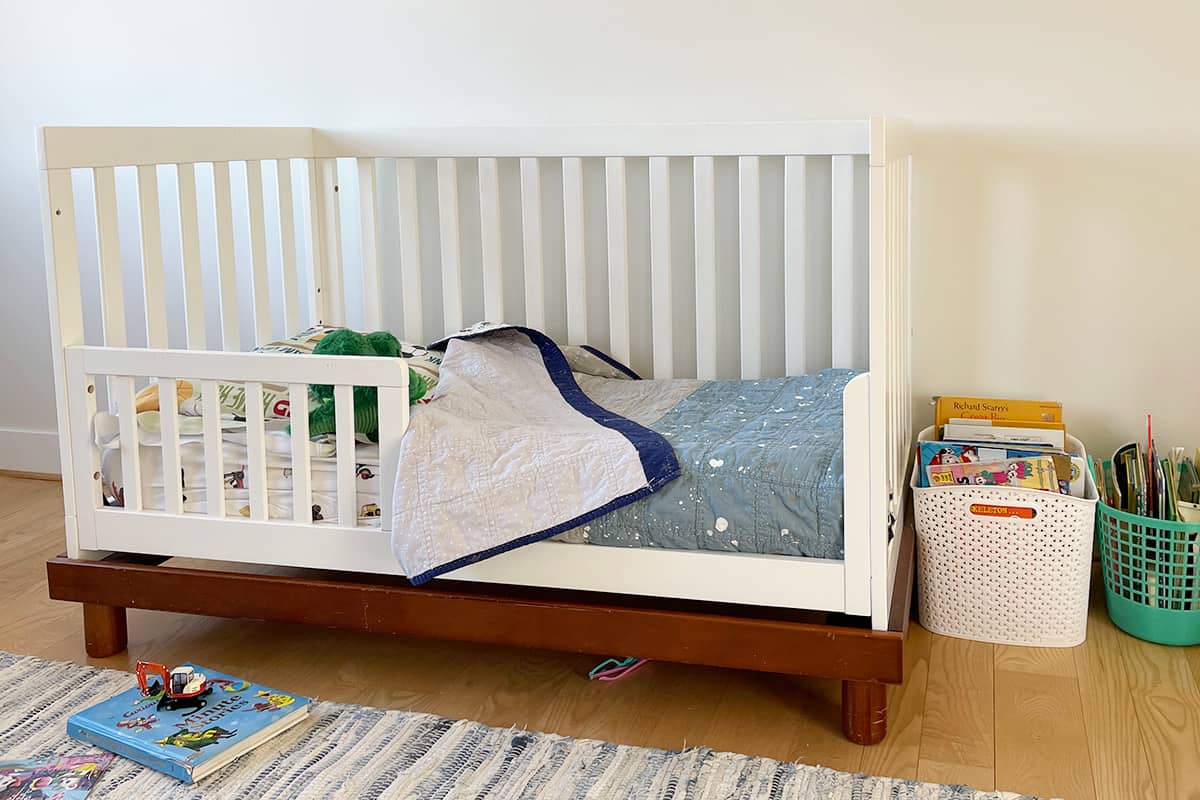What is the best way to transition to a toddler bed? The best approach is to prepare your child and the environment gradually, making the transition a positive and exciting experience. This involves timing it right, creating a comfortable and safe space, and establishing a consistent bedtime routine.
Moving your little one from a crib to a toddler bed is a significant milestone. It signals a new stage of independence and growth. But it can also be a tricky time for both you and your child. This guide gives you a step-by-step plan, including toddler bed transition tips, to make this transition as smooth and stress-free as possible.

Image Source: www.yummytoddlerfood.com
1. Is It Time? Determining the Right Moving to Toddler Bed Age
When should I transition my toddler to a bed? Most toddlers are ready to move between 18 months and 3 years old.
Figuring out the best time to move your toddler from a crib to a bed depends on your child’s individual needs and development. Here are a few factors to consider:
- Age: While the common moving to toddler bed age range is 18 months to 3 years, there’s no magic number. Some toddlers are ready earlier, while others need more time in their crib.
- Safety: If your child is starting to climb out of the crib, it’s time to consider a toddler bed for safety reasons. A fall from the crib could lead to serious injuries.
- Potty Training: Some parents choose to transition to a toddler bed around the same time as potty training. This gives the child easier access to the bathroom.
- New Sibling: Avoid transitioning your toddler right before or after the arrival of a new sibling. This can make them feel like they’re being replaced or punished. Give them a few months before or after the arrival.
- Readiness Signs: Is your toddler asking for a “big kid bed”? Are they showing more independence in other areas of their life? These can be signs that they’re ready.
2. Toddler Bed Preparation: Getting Ready for the Big Move
Preparing both your child and the environment is key for a successful transition. Toddler bed preparation involves a few important steps:
2.1. Talking to Your Toddler
Start talking about the new bed in a positive way.
* Build Excitement: Make it sound like a fun adventure. Talk about how “big kids” sleep in beds.
* Read Books: Read books about transitioning to a toddler bed. This can help normalize the idea and ease any anxieties.
* Involve Them: Let your toddler help pick out new bedding or a special pillow for their bed. This helps them feel involved and excited.
2.2. Selecting the Right Bed: Toddler Bed Size and Type
Choosing the right bed is important for safety and comfort. Let’s explore some crucial factors:
2.2.1. Toddler Bed vs Crib
What is the difference between a toddler bed and a crib? A toddler bed is smaller and lower to the ground than a crib, making it safer and easier for a toddler to get in and out.
- Toddler Bed: Specifically designed for toddlers, usually uses the same crib mattress.
- Full-Size Bed: An option for older toddlers or if you want a bed they can grow into. It will need a bed rail for safety.
- Convertible Crib: A crib that can be converted into a toddler bed. This can ease the transition as it’s a familiar piece of furniture.
2.2.2. Toddler Bed Size
Most toddler bed sizes use the same mattress size as a crib. A standard crib mattress measures about 28 inches wide and 52 inches long.
2.2.3. Safety First
- Guardrails: Make sure the bed has guardrails to prevent your child from rolling out.
- Sturdy Construction: Choose a bed made from solid materials that can withstand a toddler’s activity.
- Non-Toxic Materials: Make sure the bed is made from non-toxic materials, especially if your child tends to chew on things.
2.3. Creating a Safe Sleep Environment: Toddler Bed Safety
Toddler bed safety is extremely important when transitioning from the crib. Take these precautions to ensure your child’s well-being:
- Secure the Room: Anchor furniture to the walls to prevent it from tipping over.
- Cover Outlets: Use outlet covers to protect your child from electrical hazards.
- Remove Hazards: Remove any small objects or choking hazards from the room.
- Install a Nightlight: A nightlight can provide comfort and prevent your child from tripping in the dark.
- Place a Soft Rug: Put a soft rug next to the bed to cushion any falls.
3. Introducing Toddler Bed: The Big Day
Now that you’ve prepared everything, it’s time to introducing toddler bed to your child.
3.1. Make It a Special Occasion
- Decorate Together: Let your toddler help decorate the new bed with their favorite bedding and stuffed animals.
- Celebrate: Have a small celebration to mark the occasion. This could be a special bedtime story or a small treat.
3.2. Stick to the Routine: Toddler Bed Routine
Can I maintain the bedtime routine when switching to a toddler bed? Yes, maintaining a consistent bedtime routine is crucial for a successful transition to a toddler bed.
Maintaining the same bedtime routine will give your child a sense of security and familiarity. Here’s how to establish a toddler bed routine:
- Consistent Bedtime: Stick to the same bedtime every night.
- Relaxing Activities: Include calming activities like a warm bath, reading stories, or singing songs.
- Comfort Items: Let your child bring their favorite comfort items, like a blanket or stuffed animal, to the new bed.
- Positive Reinforcement: Praise your child for staying in bed and following the routine.
3.3. The First Night
- Stay Close: Stay with your child until they fall asleep on the first night. This can help ease any anxiety and make them feel more secure.
- Reassure Them: If they get out of bed, gently guide them back and reassure them that they are safe.
- Be Patient: It may take a few nights for your child to adjust to the new bed. Be patient and consistent with your approach.
4. Addressing Challenges: Toddler Bed Refusal Solutions
What can I do if my toddler refuses to stay in the toddler bed? Stay calm and consistent. Gently guide them back to bed, reinforce the bedtime routine, and offer positive reinforcement for staying in bed.
Not all transitions go smoothly. Be prepared for some challenges and have some toddler bed refusal solutions ready. Here are some common issues and how to address them:
4.1. Getting Out of Bed
- Gentle Guidance: If your child gets out of bed, gently guide them back without scolding.
- Consistent Response: Respond the same way every time they get out of bed. This will help them learn the boundaries.
- Check the Environment: Make sure the room is comfortable and not too hot or cold.
- Address Fears: Talk to your child about any fears they may have about sleeping in the new bed.
4.2. Bedtime Battles
- Review the Routine: Make sure the bedtime routine is consistent and relaxing.
- Offer Choices: Give your child some choices within the routine, like which pajamas to wear or which book to read. This can give them a sense of control.
- Positive Reinforcement: Reward your child for following the routine and staying in bed.
4.3. Night Wakings
- Check for Comfort: Make sure your child is comfortable and not too hot or cold.
- Offer Reassurance: If your child wakes up in the night, offer reassurance and comfort.
- Avoid Stimulation: Avoid turning on the lights or engaging in stimulating activities.
5. Toddler Bed Training: Establishing Good Sleep Habits
What does toddler bed training involve? It involves consistently reinforcing the bedtime routine, setting clear boundaries, and offering positive reinforcement for staying in bed.
Toddler bed training is about helping your child develop good sleep habits and feel comfortable in their new bed. Here are some tips:
- Consistency is Key: Be consistent with the bedtime routine and your response to any challenges.
- Positive Reinforcement: Praise and reward your child for staying in bed and following the routine.
- Daytime Practice: During the day, let your child play in the bed and get comfortable with it.
- Be Patient: It may take a few weeks for your child to fully adjust to the new bed. Be patient and supportive throughout the process.
6. Maintaining Safety: Ongoing Vigilance
Even after your toddler has successfully transitioned to a bed, it’s still important to maintain a safe sleep environment. Regularly check the room for hazards and make sure the bed is in good condition.
Table: Troubleshooting Transition Problems
| Problem | Solution |
|---|---|
| Child keeps getting out of bed | Gently guide them back each time, ensure consistent response, address fears, check room temperature. |
| Bedtime battles | Review and maintain bedtime routine, offer limited choices, use positive reinforcement. |
| Night wakings | Check for comfort, offer reassurance without stimulation, consider a nightlight. |
| Refuses to sleep alone | Stay with them until drowsy, gradually reduce your presence, use a transitional object, offer praise for sleeping alone. |
Frequently Asked Questions (FAQ)
Q: My toddler is climbing out of the crib. Is it time for a toddler bed?
A: Yes, climbing out of the crib is a clear sign that it’s time to transition to a toddler bed for safety reasons.
Q: Can I use the same crib mattress for a toddler bed?
A: Yes, most toddler beds are designed to use the same standard-size crib mattress.
Q: How long should I stay with my toddler until they fall asleep in the new bed?
A: Stay with them for as long as it takes for them to feel comfortable and secure. Gradually reduce your presence over time.
Q: What if my toddler cries when I leave the room?
A: Reassure them that you’re nearby and will check on them. You can also try leaving a comfort item with them.
Q: Should I transition to a toddler bed before or after potty training?
A: Some parents find it helpful to transition around the same time as potty training, but it’s ultimately a personal choice based on your child’s readiness.
Final Thoughts
Transitioning to a toddler bed is a big step for both you and your child. By preparing your child and the environment, establishing a consistent routine, and addressing any challenges with patience and understanding, you can make this transition a positive and successful experience. Remember that every child is different, so it’s important to tailor your approach to your child’s individual needs and personality. With a little planning and patience, you can help your toddler embrace their new bed and enjoy restful nights of sleep.

Clark Lubowitz is a parenting expert with over 10 years of experience in toddler care and child development. Holding a degree in Early Childhood Education, he specializes in blending modern technology with parenting, offering expert advice on the best toddler gadgets. Through his work on ToddlerAwesome.com, Clark provides valuable insights to help parents make informed decisions for their little ones.
